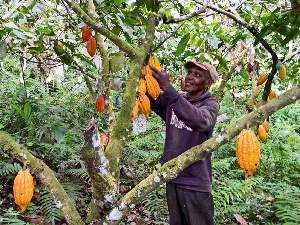The Harmattan could dry up cocoa seedlings, a situation that portends poor production for the world’s two largest cocoa producers, Ivory Coast and Ghana.
"The winds could dry up the young flowers on the cocoa trees and the flowers may turn yellow and fall," said Antoine Koffi Kouassi, an independent meteorologist who spoke to Bloomberg by phone from Abidjan.
"They may have a negative impact on the fruiting period and hurt the mid-crop," he said, in reference to the smaller of two annual harvests that typically starts around April in Ivory Coast, the world’s biggest cocoa grower. The francophone country accounts for almost 40 percent of global cocoa production.
Charles York, the principal meteorologist at the Ghana Meteorological Agency also told Bloomberg that the dry weather has been "very severe from the onset and could abort budding cocoa pods."
The winds bring dry and unseasonable cool weather to West Africa, with crops including cocoa potentially being damaged as rains usually fall below average. Cocoa prices, already up 17 percent this year, could gain a further boost from Harmattan winds as production could be short of demand.
Cocoa, already this year's best-performing commodity in the Standard & Poor’s index of 24 raw materials, rose 0.1 percent to $3,387 a metric ton on the ICE Futures U.S. exchange by 8:43 a.m. in New York. The winds, which could knock off flowers that develop into cocoa pods, will add to woes in Ghana, where farmers harvested the smallest crop in five years in the 2014-15 season ended in September.
Early Harmattan
While the Harmattan started earlier than normal, MDA Weather Services says the strongest part won’t be felt until January, Donald Keeney, a meteorologist at the Gaithersburg, Maryland-based forecaster, said in an e-mailed response to questions Monday. This will probably lead to some stress on mid-crop growth, he said.
"By February, conditions should improve a bit in Ivory Coast, while the drier pattern will likely continue in Ghana and Nigeria," he said.
Harmattan winds are starting early just as wet weather that had returned to West Africa was benefiting crops. Rainfall in Ivory Coast from the start of October through Dec. 2 was 30 percent above normal, data from Speedwell Weather showed. Dry weather earlier in the year was threatening harvests, with Ghana facing the driest third quarter in 35 years, according to Olam International, the third-largest cocoa processor.
"Harmattan at this time of the year is very troubling," Samuel Quainoo, a 54-year-old farmer who grows 124 acres (50 hectares) in the western part of Ghana, said by phone. "We haven’t gotten sufficient rains so far this season. We expected some intermittent showers to help the pods at this time of the year."
In October this year, Olam International Ltd., which became the world’s third-largest processor of the beans after buying a unit of Archer-Daniels-Midland Co., warned that Ghana’s cocoa production may be smaller than forecast as the driest third quarter in 35 years threatened the crop in the No. 2 producer.
The nation’s crop may fall short of Olam’s forecast for 750,000 metric tons if dry weather means the smaller of two annual harvests declines from last season’s level, said Amit Suri, chief operating officer of the company’s cocoa unit. Ghana missed the government’s output target last season partly due to late application of pesticides and fertilisers, he said.
Cocoa futures traded in New York climbed 9 percent this year as the West African nation’s crop fell short of forecasts and an El Nino weather pattern threatened to cut output from Ecuador to Indonesia, the world’s third-largest cocoa producer. The beans used to make chocolate are this year’s biggest gainer in the Standard & Poor’s GSCI index of 24 raw materials.
"If El Nino is strong, that will bring the numbers down for the mid-crop," Suri said in an interview in London, saying Olam’s forecasts assumed mid-crops would be unchanged from last year. "While October has seen better rainfall in Ghana, the weather needs to stay like this for the mid-crop to have a chance."
El Nino
Rainfall in Ghana in the first half of October was more than the total of the past two months, Speedwell Weather said Oct. 15. El Nino usually reduces global production by an average 2.4 percent, with Ecuador being the most affected country, according to a study by the International Cocoa Organization in London. In West Africa, the weather pattern causes output to decline by about 2 percent in Ivory Coast and by 1.7 percent in Ghana.
Global cocoa demand will outstrip supplies by 150,000 tons in the 2015-16 season that started this month as processing rebounds, Olam estimates. That compares with an ICCO forecast for a shortage of 96,000 tons and estimates ranging from a surplus of 92,000 tons to a shortfall of 297,000 tons in a Bloomberg survey published last month.
"This number could grow quite quickly if the mid-crops are smaller," Suri said.
Ivory Coast, the world’s largest producer, will gather 1.65 million tons, down from more than 1.8 million tons last season, Olam estimated. The crop could still be smaller depending on the size of the mid-crop, Suri said. Dryness in Indonesia and wet weather in Ecuador caused by El Nino could further reduce harvests.
Global processing will rebound 2 percent even as chocolate confectionery consumption remained unchanged in the past year, Suri said. Grindings fell 4 percent last season as chocolate makers used up inventories of cocoa products, he said. Olam is now the world’s biggest grinder after Barry Callebaut AG and Cargill Inc., Gerry Manley, a director at the company, said in the same interview.
"We need to keep grinding to come up with zero consumption," Suri said. "We don’t believe consumption is dropping because people are buying less, but because chocolate makers are managing costs," he said, adding that they were using tactics such as reducing the size of bars.
Business News of Wednesday, 9 December 2015
Source: classfmonline.com













